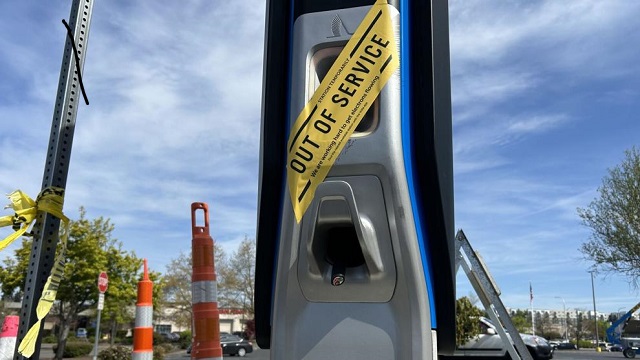Automotive
State: 1 in 5 charge failures a ‘substantial risk’ to Washington’s EV strategy

From The Center Square
By TJ Martinell
The Harvard study also noted a lack of public charging ports in regions of Washington such as Ferry County, where the county’s only existing public charging port has been removed. It’s a problem the Harvard study attributes to a lack of EV car sales.
Washington state’s goal of shifting the transportation sector away from fossil fuels and toward electrification is at “substantial risk” due to the documented unreliability of public charging stations, according to a state electric vehicle council.
Per a state law, the sale and registration of fossil fuel vehicles made in 2030 or after will be illegal in Washington. To make the use of EVs feasible, the state will need to have fast-charging electric vehicle ports every 50 miles across the state highway state, and 3 million total in both public and private charging ports.
But, there’s a catch.
The estimate assumes every one of the public charging ports will be functional.
Meanwhile, one out of every five attempted charges at a public port fails, according to a Harvard-led study. Released in June, the study found that just 78% of attempted charges at the nation’s roughly 64,000 public port succeeds, making them less reliable than gas stations.
“Imagine if you go to a traditional gas station and two out of 10 times the pumps are out of order,” scholar Omar Asensio said in a news release.
Asensio is the climate fellow at Harvard Business School’s Institute for the Study of Business in Global Society, or BiGS, and led the study.
The Harvard study also noted a lack of public charging ports in regions of Washington such as Ferry County, where the county’s only existing public charging port has been removed. It’s a problem the Harvard study attributes to a lack of EV car sales.
The one in five failure rate could prove to be a logistical challenge for the state EV Coordinating Council, which is tasked with creating the electrification strategy for the state’s transportation sector, with public charging ports a key aspect of that strategy.
The state Legislature has already invested $184 million for passenger EV charging to build 752 fast charging ports, while additional federal funding is expected to bring the total to 1,019 fast charging ports; the state currently has 1,283 fast charging ports in presumed operation.
The council’s Transportation Electrification Strategy estimates there will need to be 3,030 public fast charging ports for light-duty vehicles by 2025; the council estimates that there will need to be 728 private ports to meet EV charging demand.
However, in an Aug. 6 draft proposal under development by the Washington State Department of Commerce’s Clean Transportation Unit, it states that the failure rate means “the state would need to overbuild total ports to reach the targets.
“Public fast charging investments and reliability need stronger improvement,” the proposal goes on to say. “For consumers without experience using an EV, it is often not clear that most charging takes place at home unless such access is not feasible or driving exceeds 150-200 miles each day. This makes public charging convenience and reliability a key component of public willingness to make the transition to electric.”
However, the draft proposal adds that “beyond ensuring there’s sufficient public charging access to support EV adoption, unreliable public charging is a substantial risk to adoption if not urgently improved. Reliability is especially key because there was no reliability factor assumed, meaning a port needed is assumed to be a port that functions.”
The current draft proposal seeks $103 million for the 2025-27 operating budget, $90 million of which would fund an ongoing EV rebate program that started earlier this month.
The Department of Commerce is currently soliciting public feedback on the draft proposal through a survey that is open through Aug. 16. The draft proposal is ultimately due to the Governor’s Office by Sept. 10.
TJ Martinell
Staff Reporter
Automotive
America’s EV Industry Must Now Compete On A Level Playing Field


From the Daily Caller News Foundation
America’s carmakers face an uncertain future in the wake of President Donald Trump’s signing of the One Big Beautiful Bill Act (OBBBA) into law on July 4.
The new law ends the $7,500 credit for new electric vehicles ($4,000 for used units) which was enacted as part of the 2022 Inflation Reduction Act as of September 30, seven years earlier than originally planned.
The promise of that big credit lasting for a full decade did not just improve finances for Tesla and other pure-play EV companies: It also served as a major motivator for integrated carmakers like Ford, GM, and Stellantis to invest billions of dollars in capital into new, EV-specific plants, equipment, and supply chains, and expand their EV model offerings. But now, with the big subsidy about to expire, the question becomes whether the U.S. EV business can survive in an unsubsidized market? Carmakers across the EV spectrum are about to find out, and the outlook for most will not be rosy.
These carmakers will be entering into a brave new world in which the market for their cars had already turned somewhat sour even with the subsidies in place. Sales of EVs stalled during the fourth quarter of 2024 and then collapsed by more than 18% from December to January. Tesla, already negatively impacted by founder and CEO Elon Musk’s increased political activities in addition to the stagnant market, decided to slash prices in an attempt to maintain sales momentum, forcing its competitors to follow suit.
But the record number of EV-specific incentives now being offered by U.S. dealers has done little to halt the drop in sales, as the Wall Street Journal reports that the most recent data shows EV sales falling in each of the three months from April through June. Ford said its own sales had fallen by more than 30% across those three months, with Hyundai and Kia also reporting big drops. GM was the big winner in the second quarter, overtaking Ford and moving into 2nd place behind Tesla in total sales. But its ability to continue such growth absent the big subsidy edge over traditional ICE cars now falls into doubt.
The removal of the per-unit subsidies also calls into question whether the buildout of new public charging infrastructure, which has accelerated dramatically in the past three years, will continue as the market moves into a time of uncertainty. Recognizing that consumer concern, Ford, Hyundai, BMW and others included free home charging kits as part of their current suites of incentives. But of course, that only works if the buyer owns a home with a garage and is willing to pay the higher cost of insurance that now often comes with parking an EV inside.
Decisions, decisions.
As the year dawned, few really expected the narrow Republican congressional majorities would show the political will and unity to move so aggressively to cancel the big IRA EV subsidies. But, as awareness rose in Congress about the true magnitude of the budgetary cost of those provisions over the next 10 years, the benefit of getting rid of them ultimately subsumed concerns about the possible political cost of doing so.
So now, here we are, with an EV industry that seems largely unprepared to survive in a market with a levelized playing field. Even Tesla, which remains far and away the leader in total EV sales despite its recent struggles, seems caught more than a little off-guard despite Musk’s having been heavily involved in the early months of the second Trump presidency.
Musk’s response to his disapproval of the OBBBA was to announce the creation of a third political party he dubbed the American Party. It seems doubtful this new vanity project was the response to a looming challenge that members of Tesla’s board of directors would have preferred. But it does seem appropriately emblematic of an industry that is undeniably limping into uncharted territory with no clear plan for how to escape from existential danger.
We do live in interesting times.
David Blackmon is an energy writer and consultant based in Texas. He spent 40 years in the oil and gas business, where he specialized in public policy and communications.
Automotive
Federal government should swiftly axe foolish EV mandate

From the Fraser Institute
Two recent events exemplify the fundamental irrationality that is Canada’s electric vehicle (EV) policy.
First, the Carney government re-committed to Justin Trudeau’s EV transition mandate that by 2035 all (that’s 100 per cent) of new car sales in Canada consist of “zero emission vehicles” including battery EVs, plug-in hybrid EVs and fuel-cell powered vehicles (which are virtually non-existent in today’s market). This policy has been a foolish idea since inception. The mass of car-buyers in Canada showed little desire to buy them in 2022, when the government announced the plan, and they still don’t want them.
Second, President Trump’s “Big Beautiful” budget bill has slashed taxpayer subsidies for buying new and used EVs, ended federal support for EV charging stations, and limited the ability of states to use fuel standards to force EVs onto the sales lot. Of course, Canada should not craft policy to simply match U.S. policy, but in light of policy changes south of the border Canadian policymakers would be wise to give their own EV policies a rethink.
And in this case, a rethink—that is, scrapping Ottawa’s mandate—would only benefit most Canadians. Indeed, most Canadians disapprove of the mandate; most do not want to buy EVs; most can’t afford to buy EVs (which are more expensive than traditional internal combustion vehicles and more expensive to insure and repair); and if they do manage to swing the cost of an EV, most will likely find it difficult to find public charging stations.
Also, consider this. Globally, the mining sector likely lacks the ability to keep up with the supply of metals needed to produce EVs and satisfy government mandates like we have in Canada, potentially further driving up production costs and ultimately sticker prices.
Finally, if you’re worried about losing the climate and environmental benefits of an EV transition, you should, well, not worry that much. The benefits of vehicle electrification for climate/environmental risk reduction have been oversold. In some circumstances EVs can help reduce GHG emissions—in others, they can make them worse. It depends on the fuel used to generate electricity used to charge them. And EVs have environmental negatives of their own—their fancy tires cause a lot of fine particulate pollution, one of the more harmful types of air pollution that can affect our health. And when they burst into flames (which they do with disturbing regularity) they spew toxic metals and plastics into the air with abandon.
So, to sum up in point form. Prime Minister Carney’s government has re-upped its commitment to the Trudeau-era 2035 EV mandate even while Canadians have shown for years that most don’t want to buy them. EVs don’t provide meaningful environmental benefits. They represent the worst of public policy (picking winning or losing technologies in mass markets). They are unjust (tax-robbing people who can’t afford them to subsidize those who can). And taxpayer-funded “investments” in EVs and EV-battery technology will likely be wasted in light of the diminishing U.S. market for Canadian EV tech.
If ever there was a policy so justifiably axed on its failed merits, it’s Ottawa’s EV mandate. Hopefully, the pragmatists we’ve heard much about since Carney’s election victory will acknowledge EV reality.
-

 Fraser Institute1 day ago
Fraser Institute1 day agoBefore Trudeau average annual immigration was 617,800. Under Trudeau number skyrocketted to 1.4 million annually
-

 MAiD1 day ago
MAiD1 day agoCanada’s euthanasia regime is already killing the disabled. It’s about to get worse
-

 Frontier Centre for Public Policy1 day ago
Frontier Centre for Public Policy1 day agoNew Book Warns The Decline In Marriage Comes At A High Cost
-

 Business1 day ago
Business1 day agoPrime minister can make good on campaign promise by reforming Canada Health Act
-

 Addictions1 day ago
Addictions1 day ago‘Over and over until they die’: Drug crisis pushes first responders to the brink
-

 International1 day ago
International1 day agoChicago suburb purchases childhood home of Pope Leo XIV
-

 Daily Caller1 day ago
Daily Caller1 day agoUSAID Quietly Sent Thousands Of Viruses To Chinese Military-Linked Biolab
-

 Business2 days ago
Business2 days ago103 Conflicts and Counting Unprecedented Ethics Web of Prime Minister Mark Carney




